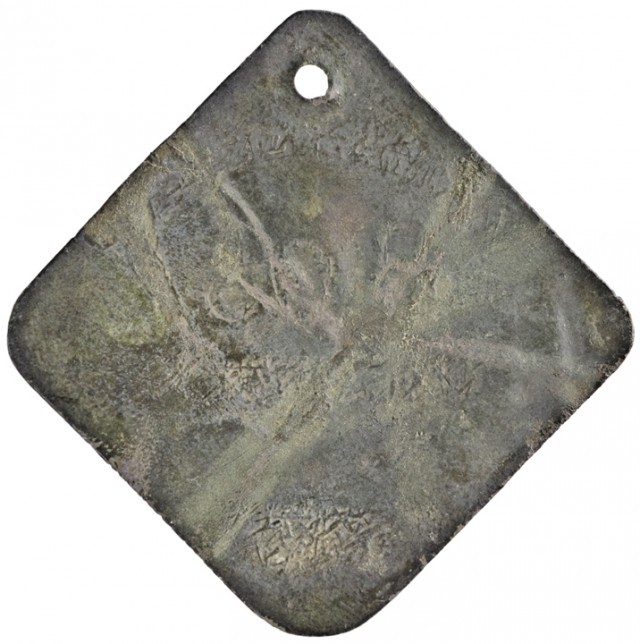The Last Of America's Slave Tags

Would you like to buy something weird? Hammer Time is our guide to things that are for sale at auction: fantastic, consequential and freakishly grotesque archival treasures that appear in public for just a brief moment, most likely never to be seen again.
“There’s just one more thing,” the curator of history said, as we were about to hang up the phone, “but I’m not sure if I should tell you.”
I had called J. Grahame Long of the Charleston Museum in South Carolina about a slave tag from 1850 up for sale at the Early American Store. There can be a kind of vexing fetishism that accompanies antebellum ephemera — as with Nazi memorabilia — and our discussion largely consisted of the research and exhibition function of such challenging material. The Charleston Museum, which is America’s first museum, has the largest collection of copper tags in the country. They have 54.
They could have far more, Long said, knowing that what he was about to divulge would be impossible to ignore. Every year, more than a hundred tags come across his desk, and 99 of them turn out to fake.
In the early 20th century, novelty tags — fakes — were sold as souvenirs in Charleston. It might have begun at the well-attended but financially disastrous South Carolina Interstate and West Indian Exposition. The regional trade show opened in 1901, and attracted more tourists than Charleston had seen since the Civil War, with more than 670,000 visitors, including President Theodore Roosevelt. They were eager to pick up mementos from the city where, just after South Carolina became the first state to secede, troops in the city fired on the transport ship Star of the West, announcing the war with a 34-hour bombardment.
When it came to the slave trade, the port city of Charleston had been the nation’s capital. Other cities, including New Orleans and Savannah, had a badge system in place (no examples remain) but Charleston implemented the most formal system, and proof in the form of exonumia was in demand.
Now fakes flood the market. It’s easy to imagine that, at least in the beginning, some of the silversmiths found leftover supplies, using an original mold, the last of the dies and stamps once issued by the city. From the anachronistic safety of 2013, I try to understand why a tourist, or, as it seems, many tourists, would be moved to purchase such a thing. I imagine them wandering storefronts, tired of looking and sightseeing. They would have passed by textiles, prints and photographs of notable sights and victories of the Confederacy unmoved, before pausing before a display of slave tags. Did they pick one up and inspect it, trying to decipher what it was. Would they have recognized it upon first glance?
“This is a time that is gone and will never come again, and perhaps it appealed to people in a gothic sense,” Long said, after considering more vile impetuses behind the purchase. ”It’s the horror of human history.”
Each (real) medallion is under 2 inches square, and lists the city, the year, the slave’s specialty, and an issue number. At the end of each year, they expired. According to the Statement of Receipts and Expenditures by the City Council of Charleston from the 1st July 1849, to 1st July 1850, a pamphlet issued by the treasurer’s office, there were a finite amount of badges issued for each trade. Servants received 2,400 badges, half of the total of 4,480 issued that year, with porters coming in second at 1,400, mechanics at 400, fruiterers at 180, and finally, there were 100 fishers. The city had a fixed fee set by trade and skill.
Some historians have described the tags as medallions worn around the neck or wrist, but Long says they were sewn onto clothes, worn as an identifying badges.
“At the time, folks were concerned about slaves roaming around town, especially after Denmark Vesey,” Long said. In 1822, Vesey planned a Bastille Day insurrection in which slaves would execute slave-owners. Unfortunately, his plot was discovered and he, along with dozens of others, was hanged.
One-quarter to one-third of white families in the south were slaveholders, but in general slaves rarely left the plantations. The tags tell the far lesser-known story of urban slavery. City dwelling slaves were sometimes rented out to those who needed, but could not afford regular, supplemental labor. This was profitable for the slave’s master, and even sometimes the slave, when the additional income was actually shared. It was also profitable for the city. Slave-owners paid fees to the city. The “for hire” slaves were often encouraged to develop a special skill, and sometimes offered a modicum of independence, spending nights, or even the majority of their time, in “live-out” sections of towns.
Little is known about non-plantation slavery. Long chooses to see a small shred of hope in it. “Maybe he could save enough money to purchase his freedom or his families’,” he said, “or something he really needed.”
The slave hire tag, number “805,” is currently for sale at the Early American store for $2,995.00, and they attest to its authenticity. For occupation, the tag reads “servant.”

Alexis Coe’s work has appeared in the Atlantic, Slate, The Millions, The Hairpin, SF Weekly, The Toast, and other publications. She holds an MA in history, and was a research curator at the New York Public Library.
